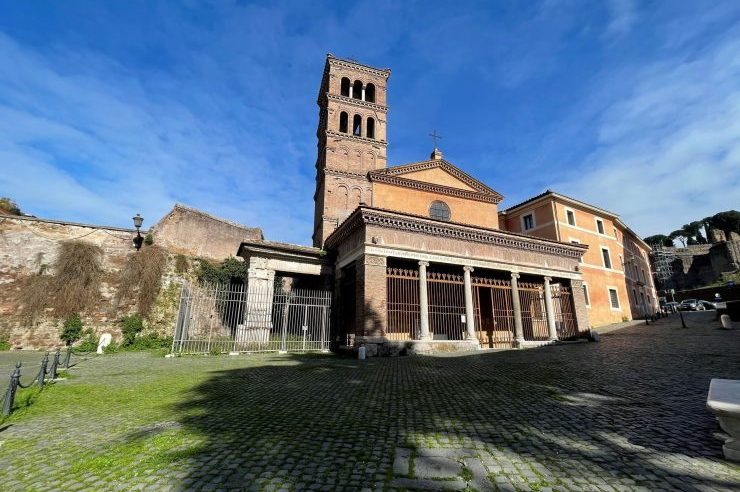“The daily station church pilgrimages … remind us that our entire life is one of journeying towards heaven. “
One of the oldest traditions of Lent is the pilgrimage to the Roman station churches. The station churches, or statio, have their roots in the earliest days of the Church, when the bishop would visit the churches of his diocese on set days each year. Today, the Catholic community in Rome carries on this tradition.
During the first three hundred years of Christianity, communities would gather in homes for communal worship. Long before it was legal to build churches, Mass was said in house churches. These churches were known by the names of their owners: titulus Pudentis, titulus Lucinae, etc. By the end of the first century, the Church had grown large enough that there were many of these house churches in each city. Bishops visited the churches in their area to show the unity of the Church.
In Rome, the bishop, as successor of St. Peter and head of the entire Christian Church, visited the principle house churches in a similar fashion. After the Peace of Constantine in 313 AD, churches were built near or on these sites. These churches housed the relics precious to the Christian community and were the community’s connection to the martyrs. As the practice of visiting these churches and their relics continued, it became customary to visit them during the season of Lent. By the fourth century, visits to these churches took on a penitential, pilgrimage character.
Thus the station churches are among the oldest churches in Rome, and the pilgrimage to each of them continues today. Each station church has a designated day during Lent – we always visit Santa Sabina, for example, on Ash Wednesday. The list of station churches in Rome and their days have remained pretty constant since Pope Leo III (795-816).
In a normal non-pandemic year, the English-speaking community celebrates Mass at each station church at 7am. This is coordinated by the North American College seminarians and priests (and accompanied by seminarians and priests of the English College, Irish College, and Scottish College). Masses can be heard in various languages throughout the day, and the day concludes with Mass at 5pm in Italian and Latin with the Collegium Cultorum Martyrum.
Having lived in the Eternal City twice during Lent, some of my fondest Rome memories include these Masses and the little community that made those morning pilgrimages. It was definitely a Lenten sacrifice to wake up before the sun rose and make my way to various parts of the city, but I was well rewarded. There was always a beautiful liturgy waiting for me in an incredible jewel of a church – often a church that I would otherwise have never seen.
Walking through the cobblestone streets before the city woke up, seeing the sun rise against the orange and yellow-hued buildings, knowing I was often walking the same streets as not just Peter or Paul, but Philip Neri and Catherine of Siena, Paul of the Cross and Gregory the Great, Dominic and Francis, Elizabeth Ann Seton and Therese of Lisieux, gave me a completely different experience of Rome than the average tourist.
There was a faithful community that made the pilgrimage each morning, and there was a kinship shared amongst us, even if we never met or saw each other again after Lent was over. I remember regularly seeing “Catholic celebrities” like George Weigel or John Allen. But I just as vividly remember the college kid with his backpack who would come faithfully every morning. Truly, just as the station churches showed the unity of the Church in the second century, it continues to show that unity today.
It also continues to be our connection to the martyrs, as almost every station church has the relics of an early martyr. Some are well-known, like St. Lawrence and St. George. Others are less-known, like St. Prisca and St. Balbina. Each station is a history lesson in the rich heritage of the Church. Little-known Saint Prisca is the protomartyr of the West, baptized by Peter and beheaded during the reign of Claudius (41-54). St. Paul spent two years of his house arrest where the church of Santa Maria in Via Lata stands and St. John the Evangelist was boiled in oil where San Giovanni a Porta Latina is today. Going to Mass at San Martino ai Monti means praying at the spot where the Nicene Creed was first publicly proclaimed in Rome.
We celebrate the same liturgy the martyrs had celebrated, walk in the footsteps of past saints on pilgrimage, and share the early morning hours with fellow Christians who are, like us, in via, still “on the way.” The daily station church pilgrimages make the season of Lent a pilgrimage. They remind us that our entire life is one of journeying towards heaven.
Since most of us are unable to travel to Rome this Lent, my friend Mountain Butorac and I are releasing daily podcasts about the station churches. You can find The Catholic Traveler podcast most places you find your podcasts. Mountain is also creating daily videos of the churches. Even in the midst of travel restrictions, we can make a virtual pilgrimage to some of the greatest churches of Rome. In this time when we perhaps need it more than ever, may the station churches remind us of the unity of the Church that has survived schisms and heresies, the rich history of the Church that has survived earthquakes, wars, and plagues, and the enduring promise of Christ to be with us ‘on the way.’
“How well it is for the Christian soul to behold the city which is like a heaven on earth, full of the sacred bones and relics of the martyrs, and bedewed with the precious blood of those witnesses for truth; to look upon the image of our Savior, venerable to all the world, to mark the footprints in the solid stone, forever worthy of the worship of the nations, to roam at will from tomb to tomb rich with the memories of the Saints; to wander at random through the basilicas of the Apostles, with no other company than good thoughts.” –Petrarch
Please help spread the Gospel! Share this article on Facebook and other social media.

Please help us continue our mission!
We welcome both one-time and monthly donations. A monthly subscriber giving just $10 a month will help cover the cost of operating Integrated Catholic Life for one day! Please help us bring enriching and inspiring Catholic content to readers around the world by giving today.
Thank you and may God Bless you for supporting the work of Integrated Catholic Life! Integrated Catholic Life Inc is a nonprofit public charity under Internal Revenue Code Section 501(c)(3). These contributions are tax-deductible as provided under U.S. tax laws.















